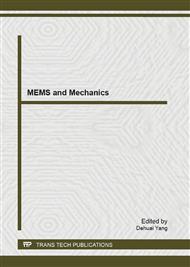[1]
G.F. Naterer, 2005, "Embedded converging surface microchannels for minimized friction and thermal irreversibilities", Int. J. of Heat Mass Transfer,48:1225–1235.
DOI: 10.1016/j.ijheatmasstransfer.2004.10.016
Google Scholar
[2]
G.F. Naterer, 2004, "Adaptive surface microprofiling for microfluidic energy conversion", J. Thermophys. Heat Transfer, 18(4).
DOI: 10.2514/1.8728
Google Scholar
[3]
S. Yu and T.A. Ameel, 2001, "Slip flow heat transfer in rectangular microchannels", Int. J. of Heat Mass Transfer, 44(22):4225–4234.
DOI: 10.1016/s0017-9310(01)00075-8
Google Scholar
[4]
C. Y. Zhao, and T. J. Lu, 2002, "Analysis of microchannel heat sinks for electronics cooling," Int. J. Heat Mass Transfer, 45(24): 4857–4869
DOI: 10.1016/s0017-9310(02)00180-1
Google Scholar
[5]
W. A. Khan and M. M. Yovanovich, 2008, "Analytical modeling of fluid flow and heat transfer in microchannel/nanochannel heat sinks", J. Thermophys. Heat Transfer, 22(3):352–359.
DOI: 10.2514/1.35621
Google Scholar
[6]
C. K. Chen, H. Y. Lai, C. C. Liu, 2011," Numerical analysis of entropy generation in mixed convection flow with viscous dissipation effects in vertical channel", Int. Comm. Heat Mass Transfer. 38(3): 285-290.
DOI: 10.1016/j.icheatmasstransfer.2010.12.016
Google Scholar
[7]
N. Guerroudj, H. Kahalerras, 2010," Mixed convection in a channel provided with heated porous blocks of various shape", Energy Conversion Management., 51: 505-517.
DOI: 10.1016/j.enconman.2009.10.015
Google Scholar
[8]
K. Hooman and A. Ejlali, 2007," Entropy generation for forced convection in a porous saturated circular tube with uniform wall temperature", Int. Comm. Heat Mass Transfer. 34: 408–419.
DOI: 10.1016/j.icheatmasstransfer.2006.10.008
Google Scholar
[9]
A. H. A. Al-Salim, 2008," Buoyancy effects on entropy generation due to laminar mixed convection in vertical channels", thesis for the degree of Master of Science in mechanical engineering, King Fahad university of Petroleum & Minerals.
Google Scholar
[10]
A. Jain and M. K. Jensen, 2007, "Analytical modeling of electrokinetic effects on flow and heat transfer in microchannels", Int. J. Heat Mass Transfer, 50:5161-5170.
DOI: 10.1016/j.ijheatmasstransfer.2007.07.005
Google Scholar
[11]
M. Liu, Y. Liu, Q. Guo, J. Yang, 2009, "Modeling of electroosmotic pumping of nonconducting liquids and biofluids by a two-phase flow method", J. Electroanalytical Chemistry, 636:86-92.
DOI: 10.1016/j.jelechem.2009.09.015
Google Scholar
[12]
N. Vasu and S. De, 2010, "Electroviscous effects in purely pressure driven flow and stationary plane analysis in electroosmotic flow of power-law fluids in a slit microchannel", Int. J. Eng. Sci., 48:1641-1658.
DOI: 10.1016/j.ijengsci.2010.08.015
Google Scholar
[13]
L. Zhao, L.H. Liu, 2010," Entropy generation analysis of electro-osmotic flow in open-end and closed-end micro-channels", Int. J. of Therm. Sci.., 49: 418-427.
DOI: 10.1016/j.ijthermalsci.2009.07.009
Google Scholar
[14]
A. H. Epstein, 2003," MILLIMETER-SCALE, MEMS GAS TURBINE ENGINES", Proceedings of ASME Turbo Expo 2003, Atlanta, Georgia, USA.
DOI: 10.1115/gt2003-38866
Google Scholar
[15]
L. Jiang, J.C. Mikkelsen, J.M. Koo, L. Zhang, D. Huber, S. Yao, A. Bari, P. Zhou and J.G. Santiago, 2002," Transient and sub-atmospheric performance of a closed-loop electroosmotic microchannel cooling system", THERMES 2002 Workshop, Santa Fe, New Mexico, USA.
DOI: 10.1109/tcapt.2002.800599
Google Scholar
[16]
O. R. Bakaraju, 2009," Heat transfer in electro-osmotic flow of power-law fluids in micro-channels", thesis for the degree of Master of Science in mechanical engineering , Cleveland State university.
Google Scholar
[17]
M. Gerendas and R. Pfister, 2000, "Development of a very small aero-engine," ASME Paper 2000-GT-0536, ASME Turbo Expo, Munich, Germany.
Google Scholar


